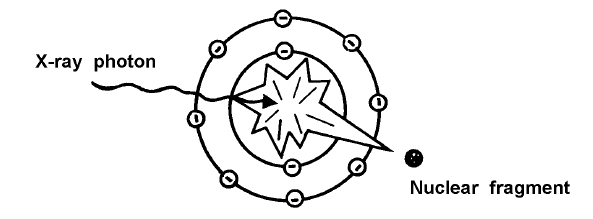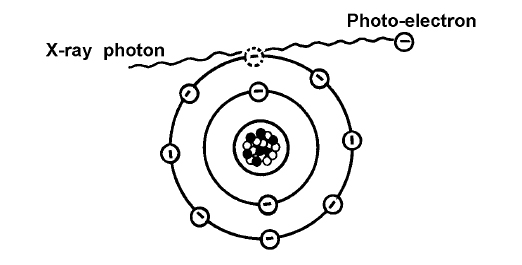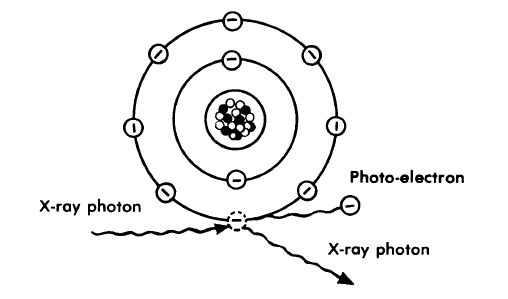

X-RAY PHOTON
A brief definition of an x-ray photon was previously stated. However, a more comprehensive definition is necessary for the next series of photon actions. X-ray photons are electromagnetic rays produced in the x-ray tube head when electrons from the cathode filament strike the anode target. They are bundles of pure energy. The photons transfer their energy to the substance through which they pass whether it be air, an x-ray film, or the living tissue of the patient or the specialist. They cannot be seen or felt.
a. Photon Action Upon Atoms.
(1) Photon collision with the nucleus of an atom. The photon may strike the nucleus of an atom.
If this occurs, the atom will be destroyed and the photon will release or expend its energy. See figure 2-6.

Figure 2-6. X-ray photon strikes the nucleus of an atom.
(2) A direct photon hit upon an electron by a photon. The photon may strike an electron with a direct hit. This action will result in the release of the photon's energy, transferring its energy to the electron. The electron will be dislodged from its shell. When an electron is dislodged in this manner, it is called a photo-electron. The dislodged or departing electron (now a photo-electron) will have energy to ionize or strike other electrons (figure 2-7). This is a form of scattered/secondary radiation, as noted earlier in the text.

(3) An indirect photon hit upon an electron. The photon may strike one of the orbiting electrons with a glancing blow, dislodging the electron from its shell. By striking a glancing blow, the photon will still possess energy and go on to strike other electrons. The dislodged electron becomes a photon-electron and will have energy itself. It, too, may strike and dislodge other electrons (figure 2-8). This is also a form of scattered/secondary radiation.

b. Photon Action Upon Living Cells.
(1) Living cells are composed of atoms and molecules. If the structure of the atoms and molecules is changed, this may adversely affect the cell. When cells are exposed to ionizing radiation, the structure of some of the atoms and molecules within the cell are changed.
(2) These are some of the effects that ionizing radiation has upon the cell.
(a) Cell death. The x-ray photon may strike a molecule in a sensitive area of a living cell and cause cell death.
(b) Toxic substances. The body is composed of a high percentage of water (H2O). The ionization (gain or loss of positive and/or negative charge) of atoms and molecules results in the breaking of the hydrogen-oxygen bond. When this occurs, there is a reforming of hydrogen and oxygen elements and hydrogen-oxygen compounds. One compound resulting from this restructuring of the atoms and molecules is hydrogen peroxide (H2O2). Hydrogen peroxide is highly toxic to cells. If large amounts of toxic substances (hydrogen-oxygen compounds) are formed, cell death will result.
(c) Mutated cell formation. The chromosomes, which are the blueprint for the formation of new cells, are changed by excessive radiation exposure, resulting in mutated cells. The new mutated cells do not function properly. When a cell is changed in this manner, the life cycle or span of the cell is changed.